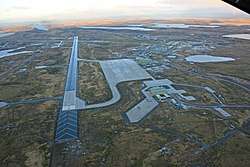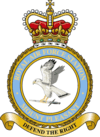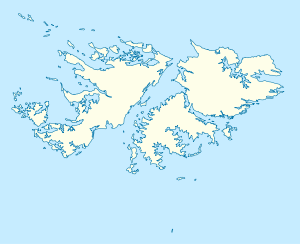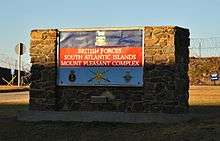RAF Mount Pleasant
| RAF Mount Pleasant | |||||||||
|---|---|---|---|---|---|---|---|---|---|
| Part of British Forces South Atlantic Islands | |||||||||
|
East Falkland Near Port Stanley in the Falkland Islands | |||||||||
 Aerial view of RAF Mount Pleasant | |||||||||
 Defend the Right | |||||||||
 RAF Mount Pleasant Shown within Falkland Islands | |||||||||
| Coordinates | 51°49′22″S 058°26′50″W / 51.82278°S 58.44722°WCoordinates: 51°49′22″S 058°26′50″W / 51.82278°S 58.44722°W | ||||||||
| Type | Permanent Joint Operating Base | ||||||||
| Site information | |||||||||
| Owner | Ministry of Defence | ||||||||
| Operator | Royal Air Force | ||||||||
| Controlled by | Joint Forces Command | ||||||||
| Site history | |||||||||
| Built | 1985 | ||||||||
| In use | 1985 – present | ||||||||
| Garrison information | |||||||||
| Occupants | |||||||||
| Airfield information | |||||||||
| Identifiers | IATA: MPN, ICAO: EGYP, WMO: 88889 | ||||||||
| Elevation | 71.1 metres (233 ft) AMSL | ||||||||
| |||||||||
| Source: Mount Pleasant Aerodrome Manual[1] | |||||||||
RAF Mount Pleasant (IATA: MPN, ICAO: EGYP) (also known as Mount Pleasant Airport, Mount Pleasant Complex or MPA)[2] is a Royal Air Force station in the British Overseas Territory of the Falkland Islands. The airfield goes by the motto of "Defend the right"[3] (while the motto of the islands is "Desire the right") and is part of the British Forces South Atlantic Islands (BFSAI). Home to between 1,000 and 2,000 British military personnel, it is located about 33 miles (53 km) southwest of Stanley,[4] the capital of the Falklands—on the island of East Falkland. The world's longest corridor, half a mile (800 m) long, links the barracks, messes and recreational and welfare areas of the station, and was nicknamed the "Death Star Corridor" by personnel.[5]
Mount Pleasant was opened by Prince Andrew on 12 May 1985, becoming fully operational the following year. The station was constructed as part of British efforts to strengthen the defence of the Falkland Islands following the 1982 war with Argentine forces. It remains the newest purpose-built RAF station and replaced previous RAF facilities at Port Stanley Airport.
History
Falklands War
RAF Mount Pleasant is the newest permanent airfield in the Royal Air Force.[6] The RAF previously had a small airfield at Stanley airfield after the end of the hostilities in 1982. During the Falklands War when the islands were occupied by Argentine military forces, British aircraft were sent to disable the runway with RAF Strike Command Vulcan bombers (Operation Black Buck) and Royal Navy Sea Harriers. The raids were moderately successful, and on the first Black Buck mission one 1,000-pound (450 kg) bomb hit the runway in the middle, disabling it. However, temporary repairs by Argentines engineers did allow C-130 Hercules transport aircraft to bring in supplies and take out casualties until the end of the conflict. At the end of hostilities the runway was fully repaired by British military engineers.
After the surrender of the Argentine ground forces on the islands, the British still faced the problem of potential Argentine air attacks from Argentina, so an aircraft carrier had to remain on station to guard the islands with its squadron of Sea Harriers until the local airfield was prepared for jet aircraft. HMS Hermes was the first to take guard duty, whilst HMS Invincible went north to change (at sea) a main engine.[7] Invincible then returned to relieve Hermes which urgently needed to return to the UK for boiler cleaning. Invincible returned until she was relieved by the newly built HMS Illustrious, which was quickly rushed south and commissioned during the journey. Once the Port Stanley runway was available for jets, Illustrious was relieved by four RAF F-4 Phantom FGR.2 (named 'Faith', 'Hope', Charity' and 'Desperation' by the crews – the first three named after the three Gloster Gladiators that according to legend were the names of the three RAF fighters defending Malta in the Second World War).
Construction
In order to deter further Argentine aggression or invasion attempts, the British Government considered it necessary to enhance the military presence in the Falklands. However, the temporary military airfield at RAF Stanley was restricted by the length and strength of its runway. Therefore, in June 1983, the British Government announced that a new military airfield would be constructed at Mount Pleasant, the option being considered to be more cost effective and straightforward than upgrading RAF Stanley. It would also allow RAF Stanley to remain operational whilst the new airfield was constructed.[8]
The Ministry of Defence reached a voluntary agreement to purchase 8,300 acres of farmland for £55,000, with severance compensation assessed at £100,000. To allow existing agricultural operations to continue, Mount Pleasant House and other farm facilities were relocated at a cost of £83,877.[9]
The airfield at Mount Pleasant was constructed by Mowlem-Laing Amey Roadstone Construction, a consortium of British civil engineering and construction firms Mowlem, John Laing Group and Amey plc. The airfield was designed to accommodate military as well as civil wide-body aircraft, enabling efficiencies in the running costs and time taken to support the Falklands garrison. The construction and shipping of materials to the Falklands was expected to cost approximately £190 million. Additional costs included the provision of a road between Stanley and Mount Pleasant and the installation of communication and navigation aids, bringing the overall cost to approximately £215m. Construction began in Autumn 1983 and the new runway was expected to be available for use by April 1985, with the wider airfield complete by February 1986.[8]
RAF Mount Pleasant was opened by Prince Andrew, Duke of York (who saw active duty during the Falklands War while serving in the Fleet Air Arm) on 12 May 1985 and became fully operational on 1 May 1986.[10]
Protecting the Falklands
Mount Pleasant's first flying unit, No. 23 Squadron, equipped with four McDonnell Douglas Phantom FGR.2, arrived from RAF Stanley on 21 April 1986. The Phantoms were joined by No. 78 Squadron on 22 May 1986, which was reformed from the former No. 1310 Flight, operating the Boeing Chinook HC1 and No. 1564 Flight, operating the Westland Sea King HAR3.[11] Later in 1986, two Lockheed C-130 Hercules C1K of No. 1312 Flight, operating in the air-to-air refuelling moved to Mount Pleasant to support the Phantoms.[12]

Responsibility for the air-defence and of the Falklands and the Phantoms of No. 23 Squadron were transferred to No. 1435 Flight on 1 November 1988. Subsequently, the flight's Phantoms were replaced when four Panavia Tornado F3 arrived in the Falklands in July 1992.
No. 1312 Flight's Hercules C1K were withdrawn in April 1996, with the flight gaining a Vickers VC10 K4 for air-to-air refuelling and C-130 Hercules C3 in the transport role.[12]
In September 2009, the Falkland's air-defence capability was enhanced when No. 1435 Flight's Tornado F3's were replaced by the Eurofighter Typhoon FGR4 in the quick reaction alert (QRA) role, at a cost of £1.56 million. To accommodate the Typhoon, a further £416,000 was spent on infrastructure improvements to the airfield.[13]
As part of the RAF's wider upgrade of their Hercules, the C3 variant of No. 1312 Flight was replaced with a C-130J C5 in April 2010. A Lockheed TriStar K1 took over the air-to-air refuelling role from the VC10 K4 in October 2013, when the latter was withdraw from RAF service. The TriStar was soon replaced itself in February 2014, by a Airbus A330 Voyager KC3.[12]
Chinook helicopters provided heavy-lift support until they were withdrawn in 2006. In 2015 Chinooks were redeployed to Mount Pleasant. A flight of Westland Sea King helicopters for support and search and rescue was located at Mount Pleasant from November 2007 until April 2016.
Prince William served as a Sea King pilot on the station for six weeks during February and March 2012.[14]
As of April 1, 2016, with the retirement of Westland Sea King the Islands' search and rescue function has been replaced by a commercial organisation, AAR, subcontracting the services to British International Helicopters for 10 years using two new AgustaWestland AW189s.
1312 Flight's Lockheed Martin C-130 Hercules, used for transport, search and rescue and maritime patrol, was replaced with a Airbus A400M Atlas C1 in April 2018.[15]
Facilities
RAF Mount Pleasant has a wide range of social and sporting facilities including a gym, swimming pool, golf course, diving centre, kart racing, Laser Quest, library, cinema, bowling, climbing wall and indoor and outdoor sports pitches. As of August 2010 it has the only cricket ground in the Falklands. There are two NAAFI shops, a Costa Coffee café, hairdressers, a medical centre, and an education centre on the station. BFBS Radio also maintains a live local station on the site. There is also a complex that includes and a small shop which is owned and run by the Falkland Islands Company.[16]
Role and operations
.jpg)
The station provides a base for air-defence and transport operations in the south Atlantic and is home to No. 905 Expeditionary Air Wing, part of British Forces South Atlantic Islands. The wing comprises three RAF flights, which operate a range of aircraft.
- Four Eurofighter Typhoon FGR4 are operated by No. 1435 Flight which provides air defence for the Falklands, South Sandwich Islands and South Georgia.[17]
- No. 1312 Flight operates an Airbus Voyager KC2 which is used for air-to-air refuelling and transportation.[17] The Voyager works alongside an Airbus A400M Atlas C1 providing tactical transport, maritime patrol, search and rescue and humanitarian assistance capabilities.[15]
- Two Boeing Chinook HC4 serve with No. 1310 Flight providing helicopter heavy-lift support.[17]
- Civilian firm, British International Helicopters (BIH), operates two Sikorsky S-61 for personnel and equipment transport. BIH also fly two AgustaWestland AW189s for search and rescue operations.[18]
Ground units include No. 7, No. 303, and No. 751 Signals Units and a Rapier detachment from the Royal Artillery. This was previously handled by the RAF Regiment but the RA now have sole responsibility for operating the Rapier.
33 Engineer Regiment (EOD) provides constant support and is part of the Joint Service Falkland Islands Detachment which consists of RAF and RLC EOD teams. It is mainly located in Stanley but there is also a detachment at Mount Pleasant. The group's role is to destroy unexploded munitions from the Falklands War; to brief troops, tourists and citizens on which areas are safe; and to mark uncleared minefields.[19]
There is also a Joint Communications Unit (JCU) providing the electronic warfare and command and control systems for the Royal Navy, British Army and Royal Air Force.[20]
Based units
Units based at RAF Mount Pleasant.[17][21][22][23]
.png)
Royal Air Force
British Army
- Infantry
- Falkland Islands Roulement Infantry Company
Joint service units
- Falkland Islands Joint Logistics Unit
- Falkland Islands Support Unit
- Joint Communications Unit Falkland Islands
- Joint Service Explosive Ordnance Disposal Unit (Detachment)
- Joint Services Provost and Security Unit
- Joint Services Signals Unit
Civilian
Airlines and destinations

Using the IATA airport code MPN, RAF Mount Pleasant also acts as the Falkland Islands' only international airport, along with its military role. Flights open to civilian passengers are operated twice each week. The Hercules C-130 Transport Force operating out of RAF Lyneham supplied a direct non-stop service from RAF Lyneham via Ascension, Wideawake Airfield. From Ascension the flight was direct involving in-flight refuelling from a C-130 tanker. The flight duration was usually about 12 hours down and 13 hours back. The last scheduled flight in the world involving in-flight refuelling to the Falklands was carried out by a crew of 24 sqn in C-130 XV291 during the period 18–23 March 1989. This was the 650th and last of its type carried out by RAF Lyneham C-130s. Flights were then operated directly by the RAF using the Lockheed TriStars of 216 Squadron. Starting in autumn 2008,[24] these flights were operated on behalf of the Royal Air Force by a civilian airline, Flyglobespan. Since the airline's bankruptcy in 2009, the flights have been operated by Air Tahiti Nui, Titan Airways, Air Seychelles and Hi Fly.[25] The service is now operated by AirTanker using Airbus Voyager aircraft.[26] They fly to and from RAF Brize Norton in Oxfordshire, with a refuelling stop at Cape Verde due to the runway at RAF Ascension Island being closed until at least 2019.[27] These flights previously used a Boeing 767 aircraft but the current aircraft is an Airbus A330. Occasionally a RAF Boeing C-17 freight aircraft or the Antonov An-225 are employed to bring in large items of freight.
Additionally, every Saturday LATAM Chile operates a scheduled commercial flight to Presidente Carlos Ibáñez del Campo International Airport of the Punta Arenas city in southern Chile, stopping at Río Gallegos, Argentina once a month.
On 2 March 2012, the Argentinian President Cristina Fernández de Kirchner called for Aerolineas Argentinas flights to Buenos Aires to replace LATAM Airlines flights to Chile. The idea of flights to Argentina was not supported in the islands, because this might result in Argentina having a monopoly on commercial flights and controlling all commercial air access.[28][29]
On 2 April 2012, a Uruguayan air company, Air Class Líneas Aéreas, gained permission from the Uruguayan Ministry of Defence to start a commercial flight to the Falkland Islands.[30]
Flights were planned to Saint Helena when the new airport was scheduled to open in 2016.[31] That airport opened to commercial flights in October 2017 after a delay, but no flights from Falklands have taken place, in part because the fairly short runway and concerns regarding wind shear prevent larger long range aircraft there.
Scheduled
| Airlines | Destinations |
|---|---|
| AirTanker | Charter: RAF Brize Norton |
| LATAM Chile | Punta Arenas, Rio Gallegos, Santiago |
Unscheduled
| Airlines | Destinations |
|---|---|
| FIGAS | Stanley, other settlements on the Falklands |
| Hi Fly | London-Gatwick, Sal |
See also
References
- ↑ "Mount Pleasant Aerodrome Manual(DAM)" (PDF). GOV.UK. Military Aviation Authority. 8 June 2015. Retrieved 4 September 2017.
- ↑ Falkland Islands Information Portal Archived 19 June 2006 at the Wayback Machine.
- ↑ Photo of an RAF Mount Pleasant plaque
- ↑ "Mount Pleasant Aerodrome Manual" (PDF). www.gov.uk. Ministry of Defence. June 2015. p. 19. Retrieved 13 January 2017.
- ↑ "Brigadier David Nicholls". Telegraph.co.uk. 22 July 2006.
- ↑ "RAF Mount Pleasant". Royal Air Force. 2012. Archived from the original on 4 March 2016. Retrieved 1 June 2012.
- ↑ "British Bases - Falklands War 1982". naval-history.net.
- 1 2 Heseltine, Michael (27 June 1983). "Falkland Islands (Strategic Airfield) – Hansard". UK Parliament. Retrieved 16 April 2018.
- ↑ Lord Orr-Ewing (10 April 1984). "Falkland Islands: Airfield Land – Hansard". UK Parliament. Retrieved 16 April 2018.
- ↑ "RAF Timeline 1980–1989". Royal Air Force. 2008. Archived from the original on 10 April 2008. Retrieved 16 April 2018.
- ↑ "# 1400, Chinook HC4, 1310 Flt". Squadron Prints. Retrieved 17 April 2018.
- 1 2 3 "# 1332, Voyager KC3, 1312 Flt". Squadron Prints. Retrieved 17 April 2018.
- ↑ "Written Answers - European Fighter Aircraft: Falkland Islands". parliament.uk. House of Commons - Hansard. 25 January 2010. Retrieved 5 December 2017.
- ↑ Bates, Stephen (10 November 2011). "Prince William to go to Falklands next year". London: The Guardian. Archived from the original on 23 December 2011. Retrieved 23 December 2011.
- 1 2 "Atlas A400M replaces Hercules at Falklands' Mount Pleasant Complex". MercoPress. 4 April 2018. Retrieved 8 April 2018.
- ↑ Falkland Islands HIVE
- 1 2 3 4 "RAF Mount Pleasant". Royal Air Force. Retrieved 8 April 2018.
- ↑ "Military Contracts". British International Helicopters. Retrieved 8 April 2018.
- ↑ Royal Engineers Archived 20 June 2006 at the Wayback Machine.
- ↑ Royal Corps of Signals Archived 29 March 2005 at the Wayback Machine.
- ↑ Pocock, Chris (2013-11-16). "RAF Retires TriStar Tankers As Voyager Fleet Grows | Defense News: Aviation International News". Ainonline.com. Retrieved 2017-12-26.
- ↑ "FOIA 2017/1418" (PDF). gov.uk. 24 February 2017. Retrieved 29 July 2017.
- ↑ Brooke-Holland, Louise (8 February 2012). "Research Briefing – The Defence of the Falkland Islands" (PDF). UK Parliament. House of Commons Library. Retrieved 15 April 2018.
- ↑ "Falkland Wool Growers Report for Week Ending 16 July 2004 - Falkland Islands News". sartma.com.
- ↑ Airbridge - Flights Archived 4 February 2010 at the Wayback Machine.
- ↑ "AIR-BRIDGE MAINTENANCE". Press release. Falkland Islands Government. 24 April 2014. Retrieved 26 June 2014.
- ↑ "Ascension Island closed to heavy aircraft until 2019/2020". ch-aviation.com. Retrieved 2017-12-26.
- ↑ Goni, Uki (2 March 2012). "Argentine president calls for direct flights from Falklands to Buenos Aires". The Guardian. London.
- ↑ "Argentina wants its airline to fly to Falklands". Reuters. 2 March 2012.
- ↑ "Green light for Uruguayan flight to Falklands; Argentine ambassador says it's not commercially viable". MercoPress.
- ↑ "Planning for when the 2016 airport, St Helena after closer links with Faklands". MercoPress.
External links
![]()
- RAF Mount Pleasant Main Website
- World Aero Data – RAF Mount Pleasant
- James Rogers and Luis Simón. The Status and Location of the Military Installations of the Member States of the European Union and Their Potential Role for the European Security and Defence Policy (ESDP). Brussels: European Parliament, 2009. 25 pp.
- MPA Falklands Memoirs 1983–1986 Memoirs of the construction of the airfield at Mount Pleasant.